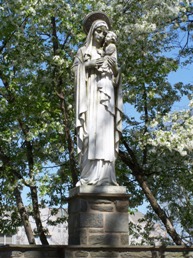A View from Falvey: The Grotto – Past, Present, Future

Our Mother of Good Counsel
By Alice Bampton
The meeting space just across the road from Falvey’s main entrance is called The Grotto, yet a grotto is understood to be a cave or “an artificial recess or structure made to represent a natural cave.” One might ask why this area is called The Grotto when it really is a Shrine to Our Mother of Good Counsel.
For the answer, one can look to the University history. Originally there was a true grotto, built between 1906 and 1907. It was a small structure “at the point where the walk from the railroad station entered the campus (near the present Falvey Hall)”(1) and was probably on the road between Falvey and Alumni Hall.
The Grotto was an ivy-covered, rounded mound with a door leading inside. On top were two statues of white Carrara marble, St. Nicholas of Tolentine on the left and St. Rita of Cascia on the right, both Augustinian saints. Inside was another statue, probably an image of the Virgin Mary as Our Mother of Good Counsel, to whom Augustinians promote devotion.

St. Rita of Cascia
The three statues for the original Grotto were purchased from the Daprato Statuary Company in Chicago, Ill., for $900. Giovanni Tonsoni was Daprato’s main sculptor, working there from 1879 until 1910 and he is likely the sculptor of the three statues. Tonsoni was a native of Carrara, Italy, the site of famous marble quarries, and he probably received his artistic training there before coming to the United States.(2) Carrara marble has been a favorite stone for sculptors throughout history, especially during the Renaissance. Michelangelo carved his “David” from Carrara marble.
The statue of St.Rita is now in one of the courtyards of the Saint Augustine Center for the Liberal Arts, but the location of the others is not known.
The original Grotto was demolished in 1949 during a campus expansion. (more…)